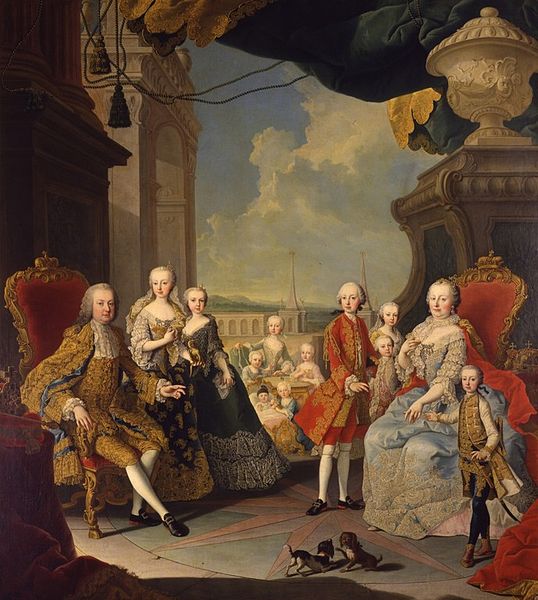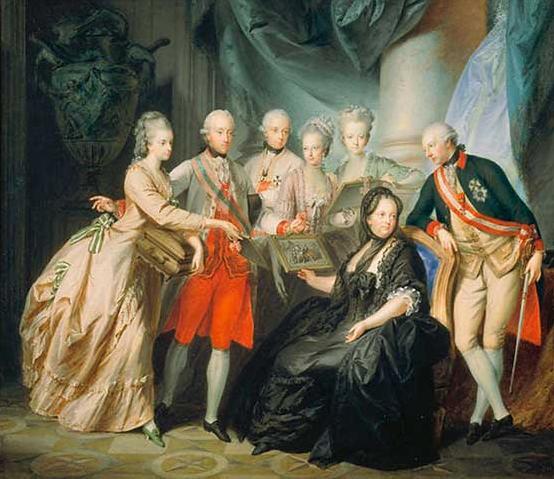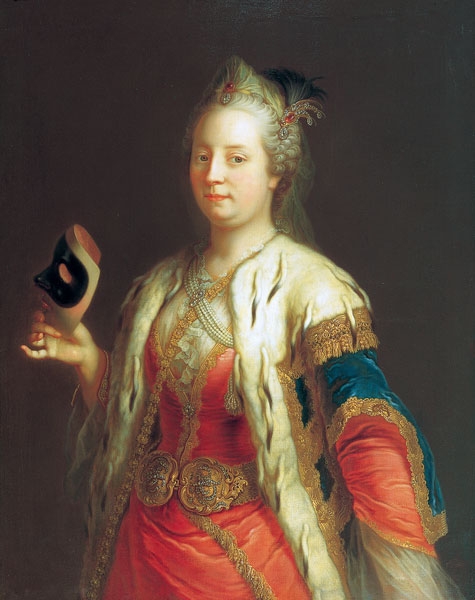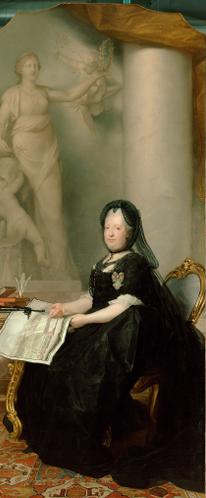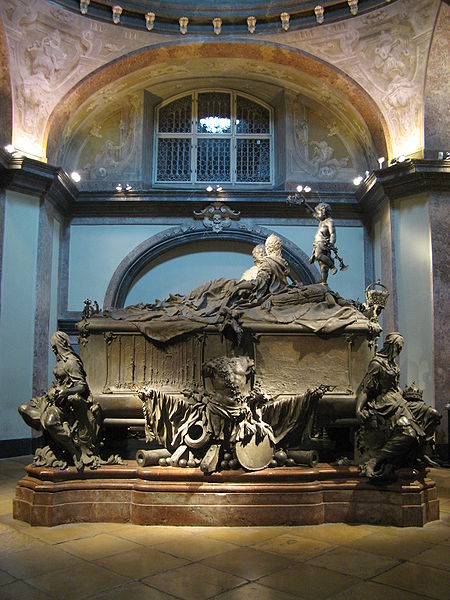<Back to Index>
- Physician Ole Worm, 1588
- Photographer Peter Henry Emerson, 1856
- Empress Consort of the Holy Roman Empire Maria Theresa Walburga Amalia Christina, 1717
PAGE SPONSOR
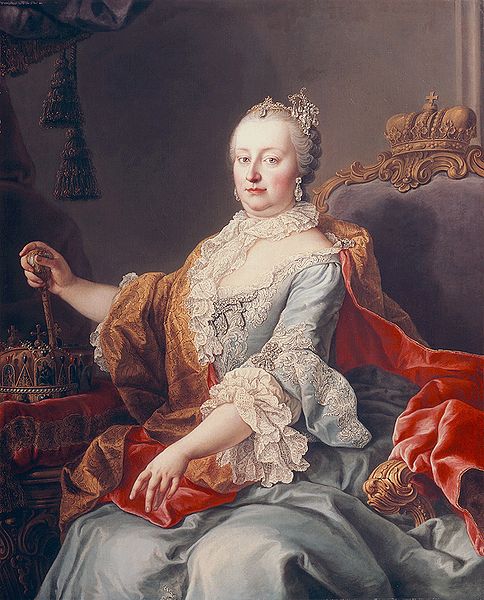
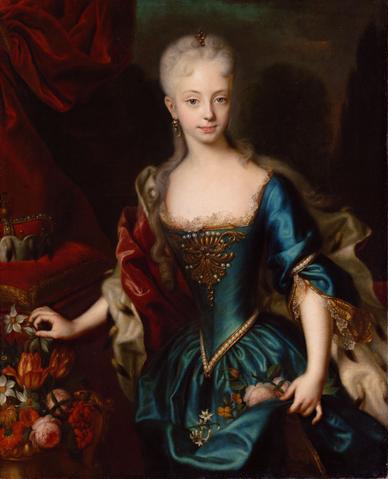
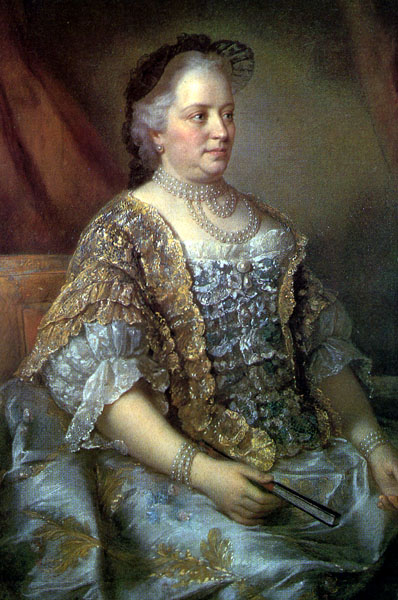
Maria Theresa Walburga Amalia Christina (13 May 1717 – 29 November 1780) was the only female ruler of the Habsburg dominions and the last of the House of Habsburg. She was the sovereign of Austria, Hungary, Croatia, Bohemia, Mantua, Milan, Lodomeria and Galicia, the Austrian Netherlands and Parma. By marriage, she was Duchess of Lorraine, Grand Duchess of Tuscany and Holy Roman Empress.
She started her 40-year reign when her father, Emperor Charles VI, died in October 1740. Charles VI paved the way for her accession with the Pragmatic Sanction of 1713, as the Habsburg lands were bound by Salic law which prevented female succession. Upon the death of her father, Saxony, Prussia, Bavaria and France repudiated the sanction they had recognised during his lifetime. Prussia proceeded to invade the affluent Habsburg province of Silesia, sparking a nine-year conflict known as the War of the Austrian Succession. Maria Theresa would later unsuccessfully try to reconquer Silesia during the Seven Years' War. She married Francis Stephen of Lorraine and had sixteen children, including Queen Marie Antoinette of France, Queen Maria Carolina of Naples, Duchess Maria Amalia of Parma and two Holy Roman Emperors, Joseph II and Leopold II. Though she was expected to cede power to Francis and Joseph, both of whom were officially her co-rulers in Austria and Bohemia, Maria Theresa was the absolute sovereign who ruled by the counsel of her advisers. She criticised and disapproved of many of Joseph's actions. Although she is considered to have been intellectually inferior to both Joseph and Leopold, Maria Theresa understood the importance of her public persona and was able to simultaneously evoke both esteem and affection from her subjects. Maria Theresa promulgated financial and educational reforms, with the assistance of Count Friedrich Wilhelm von Haugwitz and Gottfried van Swieten, promoted commerce and the development of agriculture, and reorganised Austria's ramshackle military, all of which strengthened Austria's international standing. However, she refused to allow religious toleration and contemporary travellers thought her regime was bigoted and superstitious. As a young monarch who fought two dynastic wars, she believed that her cause should be the cause of her subjects, but in her later years she would believe that their cause must be hers.
The second but eldest surviving child of Holy Roman Emperor Charles VI and Elisabeth Christine of Brunswick - Wolfenbüttel, Archduchess Maria Theresa was born early in the morning of 13 May 1717 at the Hofburg Palace, Vienna,
shortly after the death of her elder brother, Archduke Leopold. She was
baptised in the evening that day. Her aunt and her grandmother, Empress Wilhelmine Amalia and Empress Eleanor Magdalene, were her godmothers. Most descriptions of her baptism stress that the infant was carried ahead of her cousins, Archduchesses Maria Josepha and Maria Amalia, the daughters of Charles VI's elder brother and predecessor, Joseph I, before the eyes of Joseph's widow, Wilhelmine Amalia of Brunswick - Lüneburg. It was clear that Maria Theresa would outrank them, even though their grandfather, Holy Roman Emperor Leopold I, had his sons sign the decree which gave precedence to the daughters of the elder brother. Her
father was the only surviving male member of the House of Habsburg and
hoped for a son who would prevent the extinction of his dynasty and
succeed him. Thus, the birth of Maria Theresa was a great
disappointment to him and the people of Vienna; Charles never managed
to overcome this feeling. Maria Theresa replaced Maria Josepha as heiress presumptive to the Habsburg realms the moment she was born; Charles VI had issued the Pragmatic Sanction of 1713 which had placed his nieces behind his own daughters in the line of succession. Charles sought the other European powers' approval for disinheriting his nieces. They exacted harsh terms: in the Treaty of Vienna (1731), Great Britain demanded that Austria abolish the Ostend Company in return for its recognition of the Pragmatic Sanction. In total, Great Britain, France, Saxony - Poland, United Provinces, Spain, Venice, States of the Church, Prussia, Russia, Denmark, Savoy - Sardinia, Bavaria and the Diet of the Holy Roman Empire recognised the sanction. France, Spain, Saxony - Poland, Bavaria and Prussia later reneged. Little more than a year after her birth, Maria Theresa was joined by a sister, Archduchess Maria Anna, and another one, named Maria Amalia, was born in 1724. The portraits of the imperial family show that Maria Theresa resembled Empress Elisabeth Christine and Archduchess Maria Anna. The
Prussian ambassador noted that she had large blue eyes, fair hair with
a slight tinge of red, a wide mouth and a notably strong body. Neither
her parents nor her grandparents were closely related to each other,
making Maria Theresa one of few members of the House of Habsburg who
were not inbred. Maria Theresa was a serious and reserved child who enjoyed singing and archery. She was barred from horse riding by her father, but she would later learn the basics for the sake of her Hungarian coronation ceremony. The imperial family staged opera productions, often conducted by Charles VI, in which she relished participating. Her education was overseen by Jesuits. Contemporaries thought her Latin to
be quite good, but in all else, the Jesuits did not educate her well.
Her spelling and punctuation were unconventional and she lacked the
formal manner and speech which had characterised her Habsburg
predecessors. Maria Theresa developed a close relationship with Countess Marie Karoline von Fuchs - Mollard,
who taught her etiquette. She was educated in drawing, painting, music
and dancing – the disciplines which would have prepared her for the
role of queen consort. Her father allowed her to attend meetings of the council from the age of 14 but never discussed the affairs of state with her. Even
though he had spent the last decades of his life securing Maria
Theresa's inheritance, Charles always expected a son and never had his
daughter prepared for her future role as sovereign. The question of Maria Theresa's marriage was raised early in her childhood. She was first engaged to be married to Leopold Clement of Lorraine, who was supposed to visit Vienna and meet the Archduchess in 1723. However, news reached Vienna that he had died of smallpox. Leopold Clement's younger brother, Francis Stephen, was invited to Vienna. Even though Francis Stephen was his favourite candidate for Maria Theresa's hand, the
Emperor considered other possibilities. Religious differences prevented
him from arranging his daughter's marriage to the Calvinist prince Frederick of Prussia. In 1725, he betrothed her to Charles of Spain and her sister, Maria Anna, to Philip of Spain. However, other European powers compelled him to renounce the pact he had made with the Dowager Queen of Spain, Elisabeth Farnese, as the marriage of heirs to the thrones of Spain and Austria would have destroyed the European balance of power. Maria Theresa, who had become close to Francis Stephen, was relieved. Francis Stephen remained at the imperial court until 1729, when he ascended the throne of Lorraine, but was not formally promised Maria Theresa's hand until 31 January 1736, during the War of the Polish Succession. Louis XV of France demanded that Maria Theresa's fiancé surrender his ancestral Duchy of Lorraine to accommodate his father-in-law, Stanisław Leszczyński, who had been deposed as King of Poland. Francis Stephen was to receive the Grand Duchy of Tuscany upon the death of childless Grand Duke Gian Gastone de' Medici. The couple were married on 12 February 1736. The Duchess of Lorraine's love for her husband was strong and possessive. The
letters she sent to him shortly before their marriage expressed her
eagerness to see him; his letters, on the other hand, were stereotyped
and formal. She was very jealous of her husband and his infidelity was the greatest problem of their marriage, with Maria Wilhelmina, Princess of Auersperg, as his best known mistress. Upon
Gian Gastone's death on 9 July 1737, Francis Stephen ceded Lorraine and
became Grand Duke of Tuscany. In 1738, Charles VI sent the young
couple to make their formal entry into Tuscany. A triumphal arch was
erected at the Porta Galla in celebration, where it remains today.
Their stay in Florence was brief. Charles VI soon recalled them, as he feared he might die while his heiress was miles away in Tuscany. In the summer of 1738, Austria suffered defeats during the ongoing Russo - Turkish War. The Turks reversed Austrian gains in Serbia, Wallachia and Bosnia.
The Viennese rioted at the cost of the war. Francis Stephen was
popularly despised, as he was thought to be a cowardly French spy. The war was concluded the next year with the Treaty of Belgrade. Charles VI died on 20 October 1740 at the Favorita Palace, Vienna, probably because he had eaten poisonous mushrooms. He had ignored the advice of Prince Eugene of Savoy who
had urged him to concentrate on filling the treasury and equipping the
army rather than on acquiring signatures of fellow monarchs. The
Emperor, who spent his entire reign securing the Pragmatic Sanction,
left Austria in an impoverished state, bankrupted by the recent Turkish
war and the War of the Polish Succession; the treasury contained only 100,000 florins, which were claimed by his widow. The
army numbered only 80,000 men, most of whom had not been paid in
months; they were nevertheless remarkably loyal and devoted to their
new sovereign. Maria
Theresa found herself in a difficult situation. She did not know enough
about matters of state and she was unaware of the weakness of her
father's ministers. She decided to rely on her father's advice to
retain his councillors and defer to her husband, whom she considered to
be more experienced, on other matters. Both decisions, though natural,
would prove to be unfortunate. Ten years later, Maria Theresa bitterly
recalled in her Political Testament the
circumstances under which she had ascended: "I found myself without
money, without credit, without army, without experience and knowledge
of my own and finally, also without any counsel because each one of
them at first wanted to wait and see how things would develop." She
dismissed the possibility that other countries might try to seize her
territories and immediately started ensuring the imperial dignity for
herself; since a woman could not be elected Holy Roman Empress,
Maria Theresa wanted to secure the imperial office for her husband.
However, Francis Stephen did not possess enough land or rank within the
Holy Roman Empire. In order to make him eligible for the imperial throne and to enable to him to vote in the imperial elections as elector of Bohemia (which she couldn't due to her gender), Maria Theresa made Francis Stephen co-ruler of the Austrian and Bohemian lands on 21 November 1740. However, it took more than a year for the Diet of Hungary to accept Francis Stephen as co-ruler. Despite
her love for him and his position as co-ruler, Maria Theresa never
allowed her husband to decide about matters of state and often
dismissed him from council meetings when they disagreed. The first display of the new queen's authority was the formal act of homage of
the Lower Austrian Estates to her on 22 November 1740. It was an
elaborate public event which served as a formal recognition and
legitimation of her accession. The oath of fealty to Maria Theresa was taken on the same day in Hofburg. Immediately
after her accession, a number of European sovereigns who had recognised
Maria Theresa as heiress broke their promises; Queen Elisabeth of Spain
and Elector Charles Albert of Bavaria,
married to Maria Theresa's deprived cousin Maria Amalia and supported
by Empress Wilhelmine Amalia, wanted portions of her inheritance. Maria Theresa secured the recognition of King Charles Emmanuel III of Sardinia, who hadn't accepted the Pragmatic Sanction during her father's lifetime, in November 1740. In December, King Frederick II of Prussia invaded Silesia and
requested that Maria Theresa cede it, threatening to join her enemies
if she refused. Maria Theresa decided to fight for the mineral-rich
province. Frederick
even offered a compromise: he would defend Maria Theresa's rights if
she agreed to cede him at least a part of Silesia. Francis Stephen was
inclined to consider such an arrangement, but the Queen and her
advisers were not, fearing that any violation of the Pragmatic Sanction
would invalidate the entire document. Maria Theresa's firmness soon assured Francis Stephen that they should fight for Silesia and she was confident that she would retain "the jewell of the House of Austria". As Austria was short of experienced military commanders, Maria Theresa released Marshall Neipperg, who had been imprisoned by her father for his poor performance in the Turkish War. Neipperg took command of the Austrian troops in March. The Austrians suffered a crushing defeat at the Battle of Mollwitz in April 1741. France drew up a plan to partition Austria between Prussia, Bavaria, Saxony and Spain. Marshall Belle-Isle joined
Frederick at Olmütz. Vienna was in a panic, as none of Maria
Theresa's advisors expected France to betray them. Francis Stephen
urged Maria Theresa to reach a rapprochement with Prussia, as did Great Britain. Maria Theresa reluctantly agreed to negotiations. Contrary to all expectations, a significant amount of support for the young Queen came from Hungary. Her coronation as King of Hungary took place in St. Martin's Cathedral, Pressburg on 25 June 1741 after she had spent months honing the equestrian skills necessary for the ceremony and negotiating with the Diet. By July, attempts at conciliation had completely collapsed. Maria Theresa's ally, the Elector of Saxony, now became her enemy and George II declared the Electorate of Brunswick - Lüneburg to be neutral. The
Queen was once again in need of help from Hungary. In order to obtain
it, she granted favours to the Hungarian noblemen and flattered them
without conceding to all of their demands. She had already won their
support when she appeared in Pressburg in September 1741, hoping to
persuade the Diet to call a mass conscription and
recognise Francis Stephen as co-ruler. Upon achieving both goals, she
showed her gift for theatrical displays by triumphantly holding her son
and heir, Joseph, before the Diet, thereby gaining sympathy of the noblemen. In
1741, the Austrian authorities informed Maria Theresa that Bohemian
populace would prefer Charles Albert to her as sovereign. Maria
Theresa, desperate and burdened by pregnancy, wrote plaintively to her
sister: "I don't know if a town will remain to me for my delivery." She bitterly vowed to spare nothing and no one to defend her kingdom when she wrote to the Bohemian chancellor, Count Philip Kinsky: "My mind is made up. We must put everything at stake to save Bohemia." On 26 October, the Elector of Bavaria captured Prague and declared himself King of Bohemia. Maria Theresa, then in Hungary, wept on learning of the loss of Bohemia. Charles
Albert was unanimously elected Holy Roman Emperor on 24 January
1742. The Archduchess, who regarded the election as a catastrophe, caught her enemies unprepared by insisting on a winter campaign; the same day he was elected emperor, Austrian troops under Ludwig Andreas von Khevenhüller captured Munich, Charles Albert's capital. The Treaty of Breslau of June 1742 ended hostilities between Austria and Prussia. The Archduchess soon made the recovery of Bohemia her priority. French
troops fled Bohemia in the winter of the same year. On 12 May
1743, Maria Theresa had herself crowned Queen of Bohemia in St. Vitus Cathedral. Prussia
became anxious at Austrian advances on the Rhine frontier, and
Frederick sacked Prague in August 1744. The French plans fell apart
when Charles Albert died in January 1745. The French over-ran the Austrian Netherlands in May. Francis
Stephen was elected Holy Roman Emperor on 13 September 1745. Prussia
recognised Francis as emperor, and Maria Theresa once again recognised
the loss of Silesia by the Treaty of Breslau in December 1745. The war dragged on for another three years, with fighting in northern Italy and the Austrian Netherlands. The Treaty of Aix-La-Chapelle, which concluded the eight-year conflict, recognised Prussia's possession of Silesia and Maria Theresa ceded the Duchy of Parma to Philip of Spain. Frederick of Prussia's invasion of Saxony in August 1756 began the Seven Years' War. Empress Maria Theresa and Kaunitz wished to exit the war with possession of Silesia. Austria
was aligned with France and Russia; Great Britain with Prussia and
Portugal. Giving Austria huge subsidies came back to haunt France. It
could not bolster defences in New France; the British easily captured Louisbourg in 1758, and went on to conquer all of New France. Maximilian von Browne commanded the Austrian troops. Following the indecisive Battle of Lobositz in 1756, he was replaced by Prince Charles Alexander of Lorraine, Maria Theresa's brother-in-law. Frederick was startled by Lobositz; he eventually re-grouped for another attack in June 1757. The Battle of Kolin that
followed was a decisive victory for Austria. Frederick lost one third
of his troops, and before the battle was over, he had fled the scene. Maria
Theresa openly bemoaned French losses in 1758. France, having secured
the Anglo - Hanoverian neutrality for the rest of the conflict, in September 1757, lost it in January of the next year. France suffered a crushing defeat at Krefeld that June. French forces withdrew to the Rhine. In 1759, peace negotiations at The Hague came to nothing. The series of Franco-Austrian losses were reversed until, in 1762, the Empress Elizabeth of Russia died. Her successor Peter III greatly
admired Frederick, and at once withdrew Russia's support from the
French coalition. Prussia proceeded to kick the Austrians out of
Saxony, and the French out of Hesse-Kassel. Naturally, it was feared that Frederick would now invade Austria and France, and they capitulated. The peace treaties, Hubertusburg and Paris, exacted harsh terms on France, as it was forced to relinquish most of her American colonies. For Austria, though, it was status quo ante bellum. Over
the course of twenty years, Maria Theresa gave birth to sixteen
children, thirteen of whom survived infancy. The first child, Maria
Elisabeth (1737 – 1740), was born a little less than a year after the
wedding. Again, the child's gender caused great disappointment and so
would the births of Maria Anna,
the eldest surviving child, and Maria Carolina (1740 – 1741). While
fighting to preserve her inheritance, Maria Theresa gave birth to a
son, Joseph, named after Saint Joseph, to whom she had repeatedly prayed for a male child during the pregnancy. Maria Theresa's favourite child, Maria Christina, was born on her 25th birthday, four days before the defeat of the Austrian army in Chotusitz. Five more children were born during the war: Maria Elisabeth, Charles, Maria Amalia, Leopold and
Maria Carolina (1748 – 1748). During this period, there was no rest for
Maria Theresa during pregnancies or around the births; the war and
child bearing were carried on simultaneously. Five children were born
during the peace between the War of the Austrian Succession and the Seven Years' War: Maria Johanna, Maria Josepha, Maria Carolina, Ferdinand and Maria Antonia. She delivered her last child, Maximilian Francis, during the Seven Years' War, aged 39. Maria Theresa asserted that, had she not been almost always pregnant, she would have gone into battle herself. Maria
Theresa's mother, Empress Elisabeth Christine, died in 1750. Four years
later, Maria Theresa's governess, Marie Karoline von Fuchs-Mollard,
died. The Empress showed her gratitude to Countess Fuchs by having her
buried in the Imperial Crypt along with the members of the imperial family. Shortly
after giving birth to the younger children, Maria Theresa was
confronted with the task of marrying off the elder ones. She led the
marriage negotiations along with the campaigns of her wars and the
duties of state. She treated her children with affection but used them
as pawns in dynastic games and sacrificed their happiness for the
benefit of the state. A
devoted but self - conscious mother, she wrote to all of her children at
least once a week and believed herself entitled to exercise authority
over her children regardless of their age and rank. Maria Theresa came down with a severe attack of smallpox shortly after her fiftieth birthday in May 1767, caught from her daughter-in-law and empress, Maria Josepha of Bavaria. Maria
Theresa survived, but the new empress did not. Maria Theresa forced her
daughter, Archduchess Maria Josepha, to pray with her in the Imperial Crypt next
to the unsealed tomb of Empress Maria Josepha. The Archduchess started
showing smallpox rash two days after visiting the crypt and soon died.
Maria Carolina was to replace her as the pre-determined bride of King Ferdinand IV of Naples.
Maria Theresa blamed herself for her daughter's death for the rest of
her life because, at the time, the concept of an extended incubation
period was largely unknown and it was believed that Maria Josepha had
caught smallpox from the body of the late empress. In April 1770, Maria Theresa's youngest daughter, Maria Antonia, married Louis, Dauphin of France,
by proxy in Vienna. Maria Antonia's education was neglected, and when
the French showed an interest in her, her mother went about educating
her as best she could about the court of Versailles and
the French. Maria Theresa kept up a fortnightly correspondence with
Maria Antonia, now called Marie Antoinette, in which she often
reproached her for laziness and frivolity and scolded her for failing
to conceive a child. She disliked Leopold's reserve and often blamed
him for being cold. She criticised Maria Carolina for her political
activities, Ferdinand for his lack of organisation and Maria Amalia for
her poor French and
haughtiness. The only child she did not constantly scold was Maria
Christina, who enjoyed her mother's complete confidence, though she
failed to please her mother in one aspect: she did not produce any
surviving children. One of Maria Theresa's greatest wishes was to have
as many grandchildren as possible, but she had only about two dozen at
the time of her death, of which all the eldest surviving daughters were
named after her, with the exception of Caroline of Parma, her eldest
granddaughter by Maria Amalia. Like all members of the House of Habsburg, Maria Theresa was a Roman Catholic,
and a devout one as well. She believed that religious unity was
necessary for a peaceful public life and explicitly rejected the idea of religious toleration.
However, she never allowed the Church to interfere with what she
considered to be prerogatives of a monarch and kept Rome at arm's
length. She controlled the selection of archbishops, bishops and abbots. Her approach to religious piety differed from the approach of her predecessors, as she was influenced by Jansenist ideas. The empress actively supported conversion to Roman Catholicism by securing pensions to the converts. She tolerated Greek Catholics and emphasised their equal status with Roman Catholics. Besides
her devotion to Christianity, she was widely known for her ascetic
lifestyle, especially during her 15-year-long widowhood. Her relationship with the Jesuits was
of complex nature. Members of this order educated her, served as her
confessors and supervised the religious education of her eldest son.
The Jesuits were powerful and influential in the early years of Maria
Theresa's reign. However, the queen's ministers managed to convince her
that they posed a danger to her monarchical authority. Not without much
hesitation and regret, she issued a decree which removed them from all
the institutions of the monarchy and carried it out thoroughly. She
forbade the publication of Pope Clement XIII's bull which was in favour of the Jesuits and promptly confiscated their property when Pope Clement XIV suppressed the order. Though she eventually gave up trying to convert her non-Catholic subjects to Roman Catholicism, Maria Theresa regarded both the Jews and Protestants as dangerous to the state and actively tried to suppress them. The empress was probably the most anti-Semitic monarch
of her day, having inherited all traditional prejudices of her
ancestors and acquired new ones. This highly personal feature was a
product of deep religious devotion and was not kept secret in her time. In
1777, she wrote of the Jews: "I know of no greater plague than this
race, which on account of its deceit, usury and avarice is driving my
subjects into beggary. Therefore as far as possible, the Jews are to be
kept away and avoided." She
imposed extremely harsh taxes on her Jewish subjects and, in December
1744, proposed expelling the Jews from her hereditary dominions to her
ministers. Her first intention was to expel all Jews by 1 January,
but having accepted the advice of her ministers who were concerned by
the number of future expellees, had them expelled by June. She also
transferred Protestants from Austria to Transylvania and
cut down the number of religious holidays and monastic orders. In 1777,
Maria Theresa abandoned the idea of expelling Moravian Protestants
after Joseph, who was opposed to her intentions, threatened to abdicate
as emperor and co-ruler. Finally, the empress was forced to grant them
some toleration by allowing them to worship privately. Joseph regarded
his mother's religious policies as "unjust, impious, impossible, harmful and ridiculous". In the third decade of her reign, influenced by her Jewish courtier Abraham Mendel Theben,
Maria Theresa issued edicts which offered some state protection to her
Jewish subjects. She forbade forceful conversion of Jewish children to
Christianity in 1762. The next year, the empress forbade Catholic
clergy to extract surplice fee from the Jews. In 1764, she ordered the release of those Jews who had been jailed for a blood libel in the village of Orkuta. Notwithstanding her strong Judeophobia, Maria Theresa supported Jewish commercial and industrial activity. Maria
Theresa was as conservative in manners of state as in those of
religion, but implemented significant reforms to strengthen Austria's military and bureaucratic efficiency. She employed Count Friedrich Wilhelm von Haugwitz, who modernised the empire by creating a standing army of 108,000 men, paid for with 14 million gulden extracted
from each crown-land. The central government was responsible for the
army, although Haugwitz instituted taxation of the nobility, who never
before had to pay taxes. Maria Theresa oversaw the unification of the Austrian and Bohemian chancellories in May 1749. Maria
Theresa doubled the state revenue between 1754 and 1764, though her
attempt to tax clergy and nobility was only partially successful. These financial reforms greatly improved the economy. In
1760, Maria Theresa created the council of state, composed of the state
chancellor, three members of the high nobility and three knights, which
served as a committee of experienced people who advised her. The
council of state lacked executive or legislative authority, but
nevertheless showed the difference between the form of government
employed by Frederick II of Prussia. Unlike the latter, Maria Theresa
was not an autocrat who acted as her own minister. Prussia would adopt
this form of government only after 1807. In 1771, she and Joseph issued the Robot Patent,
a reform that regulated a serf's labor payments in her lands, which
provided some relief. Financially, in 1775, the Monarchy's budget was
balanced for the first time in history. Gerard van Swieten, whom Maria Theresa had recruited following the death of her sister, Archduchess Maria Anna, founded the Vienna General Hospital, revamped Austria's educational system and served as the Empress's personal physician. After
calling in van Swieten, Maria Theresa asked him to study the problem of
infant mortality in Austria. Following his recommendation, she made a
decree that autopsies would be mandatory for all hospital deaths in the
city of Graz, Austria's second largest city. This law – still in effect
today – combined with the relatively stable population of Graz,
resulted in one of the most important and complete autopsy records in
the world. Her decision to have her children inoculated after the smallpox epidemic of 1767 was responsible for changing Austrian physicians' negative view of inoculation. The empress herself inaugurated inoculation in Austria by hosting a dinner for the first sixty-five inoculated children in Schönbrunn Palace, waiting on the children herself.
Among other reforms was the Codex Theresianus, begun in 1752 and finished in 1766, that defined civil rights. In 1776, Austria outlawed witch burnings and torture, and, for the first time in Austrian history, took capital punishment off
the penal code, as it was replaced with forced labor. It was later
reintroduced, but the progressive nature of these reforms remains
noted. Much unlike Joseph, but with the support of religious
authorities, Maria Theresa was opposed to the abolition of torture.
Born and raised between Baroque and Rococo eras, she found it hard to fit into the intellectual sphere of the Enlightenment, which is why she only slowly followed humanitarian reforms on the continent.
Main reforms concerning the Roman Catholic Church were
initiated and carried out under Maria Theresa, while the reforms under
her son concerned their non-Catholic subjects. The ecclesiastic
policies of Maria Theresa, like those of her devout predecessors, were
based on primacy of government control in the relations between the
Church and the State, but not of organization of the Church. Maria
Theresa banned the creation of new burial grounds without the prior
permission of the government, thus deploring the wasteful and
unhygienic burial customs. Aware
of the inadequacy of bureaucracy in Austria and, in order to improve
it, Maria Theresa reformed education in 1775. In a new school system
based on the Prussian one, all children of both genders from the ages
of six to twelve had to attend school. Education reform was met with
hostility from many villages; Maria Theresa crushed the dissent by
ordering the arrest of all those opposed. Although the idea had merit,
the reforms were not as successful as they were expected to be; in some
parts of Austria, half of the population was illiterate well into the
19th century. The
empress permitted non-Catholics to attend university and allowed the
introduction of secular subjects (such as law), which influenced the
decline of theology as the main foundation of university education. Emperor Francis I died on 18 August 1765, while he and the court were in Innsbruck celebrating
the wedding of his second son, Leopold. Maria Theresa was devastated.
Their eldest son, Joseph, became Holy Roman Emperor. Maria Theresa
abandoned all ornamentation, had her hair cut short, painted her rooms
black and dressed in mourning for the rest of her life. She completely
withdrew from court life, public events, and theater. Throughout her
widowhood, she spent the whole August and the eighteenth of each month
alone in her chamber, which negatively affected her mental health. She
described her state of mind shortly after Francis's death: "I hardly
know myself now, for I have become like an animal with no true life or
reasoning power." Upon
his accession to the imperial throne, Joseph ruled less land than his
father had in 1740. Believing that the emperor must possess enough land
to maintain the Empire's integrity, Maria Theresa, who was used to
being assisted in the administration of her vast realms, declared
Joseph to be her new co-ruler on 17 September 1765. From then on, mother and son had frequent ideological disagreements. The
22 million gulden that Joseph inherited from his father was
injected into the treasury. Maria Theresa had another loss in February
1766 when Haugwitz died. She gave her son absolute control over the
military following the death of Count Leopold Joseph von Daun. According
to Robert A. Kann, Maria Theresa was a monarch of above average
qualifications but intellectually inferior to Joseph and Leopold. He
asserts that she nevertheless possessed qualities appreciated in a
monarch: warm heart, practical mind, firm determination and sound
perception. Most importantly, she was ready to recognise the mental
superiority of some of her advisers and to give way to a superior mind
while enjoying support of her ministers even if their ideas differed
from her own. Joseph, however, was never able to establish rapport with
the same advisers, even though their philosophy of government was
closer to Joseph's than to Maria Theresa's. The
relationship between Maria Theresa and Joseph was not without warmth
but was complicated and their personalities clashed. Despite his
intellect, Maria Theresa's force of personality often made Joseph
cower. Sometimes, she openly admired his talents and achievements, but
criticised him behind his back. She
wrote: "We never see each other except at dinner ... His temper gets
worse every day ... Please burn this letter ... I just try to avoid
public scandal." In
another letter, also addressed to Joseph's companion, she complained:
"He avoids me ... I am the only person in his way and so I am an
obstruction and a burden ... Abdication alone can remedy matters." After
much contemplation, she chose not to abdicate. Joseph himself often
threatened to resign as co-regent and emperor, but he, too, was induced
not to do so. Her threats of abdication were rarely taken seriously;
Maria Theresa believed that her recovery from smallpox in 1767 was a
sign that God wished her to reign until death. It was in Joseph's
interest that she remained sovereign, for he often blamed her for his
failures and thus avoided taking on responsibilities of a monarch. Joseph and Prince Kaunitz arranged the First Partition of Poland despite Maria Theresa's protestations. Her sense of justice pushed her to reject the idea of partition, which would hurt the Polish people.
The duo argued that it was too late to abort now. Besides, Maria
Theresa herself agreed with the partition when she realised that Frederick II of Prussia and Catherine II of Russia would do it with or without Austrian participation. Maria Theresa claimed and eventually took Galicia and Lodomeira,
a province claimed by Hungarian monarchs since the 13th century;
in the words of Frederick, "the more she cried, the more she took". It is unlikely that Maria Theresa ever completely recovered from the smallpox attack in 1767, as 18th-century writers asserted. She suffered from shortness of breath, fatigue, cough, distress,necrophobia and insomnia. She later developed edema. The
empress fell ill on 24 November 1780, ostensibly of a chill. Her
physician Dr. Störk thought her condition serious. By
28 November, she asked for the last rites, and the next day, at about nine o'clock in the evening, she died surrounded by her remaining children. With her, the House of Habsburg died out and was replaced by the House of Habsburg - Lorraine. Joseph, already co-sovereign of the Habsburg dominions, succeeded her. Maria
Theresa left a revitalised empire that influenced the rest of Europe
throughout the 19th century. Her descendants followed her example
and continued reforming the empire. The acquisition of the Kingdom of Galicia and Lodomeria gave the empire an even more multinational character that would ultimately lead to its destruction. Her introduction of compulsory schooling, as a means of Germanisation, eventually triggered the revival of Czech culture. The empress is buried in the Imperial Crypt in Vienna next to her husband in a coffin she had had inscribed during her lifetime.
